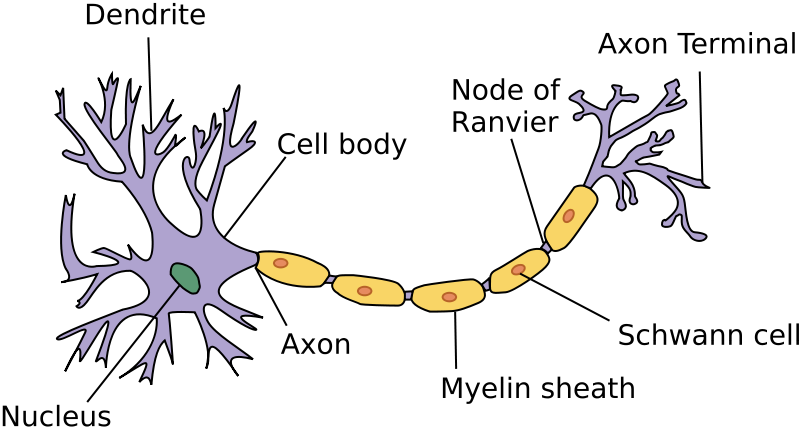Elevator-pitch: Every thought, emotion, and TikTok scroll is built on one microscopic workflow: a neuron hitting “send.” Master the hardware (anatomy), the firmware (ion channels), and the network protocol (synaptic transmission) and you’ll steam-roll the Unit 2 questions.

1. Neuron Anatomy (Physical Layer)
| Part | Key Features | Core Function | Classic AP Example |
|---|---|---|---|
| Dendrites | Branching fibers with receptor sites | Receive chemical messages | Serotonin molecules bind here to influence mood |
| Soma (Cell Body) | Nucleus + organelles | Integrates incoming signals; metabolic center | Houses the DNA that codes for ion-channel proteins |
| Axon Hillock | Cone-shaped region at soma/axon junction | “Decision gate” where graded potentials sum; if threshold (≈ –55 mV) is hit → action potential | EPSPs + IPSPs tally here |
| Axon | Long fiber; may be myelinated | Propagates electrical impulse | ~1 m long in sciatic nerve |
| Myelin Sheath | Fatty insulation (Schwann cells PNS, oligodendrocytes CNS) | Boosts speed via saltatory conduction (≈ 120 m/s) | Multiple sclerosis = demyelination |
| Nodes of Ranvier | Unmyelinated gaps | Ion exchange; AP “jumps” node-to-node | Sodium rush @ each node |
| Terminal Buttons | End bulbs containing vesicles | Release neurotransmitters into synaptic cleft | SSRIs block re-uptake at this step |
2. Electro-Chemical Workflow (Firing Sequence)
Resting Potential (–70 mV)
Inside cell: high K⁺, large negative proteins
Outside: high Na⁺, Cl⁻
Maintained by the Na⁺/K⁺ pump (3 Na⁺ out : 2 K⁺ in, ATP-driven).
Threshold & Depolarization
Summation at axon hillock hits ≈ –55 mV.
Voltage-gated Na⁺ channels fling open → Na⁺ flood → spike to +30 mV.
Repolarization
Na⁺ channels close; K⁺ channels open → K⁺ exits → voltage heads back ↓.
Hyperpolarization & Refractory Period
Drops ~5–10 mV below resting.
Absolute refractory: no firing possible (Na⁺ channels reset).
Relative refractory: strong stimulus can trigger new AP.
All-or-None Law
Intensity = frequency, not spike size (every AP is ~+30 mV).
Saltatory Conduction
AP leaps node-to-node → energy- and time-efficient.
3. Synaptic Transmission (Application Layer)
Ca²⁺ Influx at terminal button → vesicles merge with membrane.
Neurotransmitter Release into synaptic cleft (≈ 20–40 nm).
Binding to postsynaptic receptors → opens ligand-gated ion channels.
EPSP: Usually Na⁺ influx (depolarize).
IPSP: Usually Cl⁻ influx or K⁺ efflux (hyperpolarize).
Termination
Re-uptake (e.g., serotonin transporter).
Enzymatic breakdown (e.g., ACh by acetylcholinesterase).
Diffusion away from cleft.
4. Key Neurotransmitters & AP-Worthy Disorders
| Transmitter | Primary Role | Clinical Hook |
|---|---|---|
| ACh | Muscle contraction; memory | Alzheimer’s = ↓ ACh |
| Dopamine (DA) | Reward, movement | Parkinson’s = ↓ DA; Schizophrenia = DA dysregulation |
| Serotonin (5-HT) | Mood, sleep, appetite | Depression treated with SSRIs |
| Norepinephrine (NE) | Alertness, arousal | Stress response; ADHD meds boost NE |
| GABA | Main inhibitory | Low GABA → seizures/anxiety |
| Glutamate | Main excitatory; memory via LTP | Excess → excitotoxicity (stroke) |
| Endorphins | Pain relief, euphoria | Mimicked by opioids |
5. Glial Support Crew
Astrocytes: blood-brain barrier, nutrient supply
Microglia: immune defense, cleanup
Schwann / Oligodendrocytes: make myelin
Ependymal cells: produce cerebrospinal fluid
10 AP-Style Multiple-Choice Questions
(Choose the best answer; detailed rationales follow.)
The sudden influx of sodium ions during an action potential is triggered when the membrane potential reaches approximately
A. +40 mV B. –55 mV C. –70 mV D. 0 mV E. –90 mVWhich sequence correctly represents the flow of information within a typical multipolar neuron?
A. Axon → soma → dendrites
B. Terminal button → axon → dendrites
C. Dendrites → soma → axon → terminal button
D. Soma → dendrites → axon → nodes
E. Myelin → dendrites → soma → axonMultiple sclerosis primarily interferes with which aspect of neural signaling?
A. Neurotransmitter synthesis
B. Saltatory conduction along the axon
C. Calcium influx at terminal buttons
D. Ion pump function in the soma
E. Receptor binding on dendritesA neuron is unlikely to fire again during the absolute refractory period because:
A. The Na⁺/K⁺ pumps are inactive.
B. Neurotransmitters have been exhausted.
C. Voltage-gated Na⁺ channels are inactivated and cannot reopen.
D. The membrane is hyperpolarized beyond –90 mV.
E. All K⁺ channels are closed.Which statement best distinguishes graded potentials from action potentials?
A. Only graded potentials obey the all-or-none law.
B. Graded potentials travel without decrement along the axon.
C. Action potentials occur only in dendrites.
D. Graded potentials can be summed, whereas action potentials cannot.
E. Action potentials vary in amplitude; graded potentials do not.Selective serotonin re-uptake inhibitors (SSRIs) exert their effect primarily by:
A. Blocking serotonin receptors on the postsynaptic membrane
B. Inhibiting monoamine oxidase in the synaptic cleft
C. Preventing presynaptic transporters from reabsorbing serotonin
D. Increasing Ca²⁺ influx at the axon terminal
E. Enhancing synthesis of tryptophan in the somaAn influx of chloride ions into a postsynaptic neuron will most likely produce a(n):
A. Depolarizing EPSP
B. Hyperpolarizing IPSP
C. Excitatory action potential
D. Absolute refractory period
E. Release of glutamateThe strength of a stimulus is encoded in the nervous system primarily by the:
A. Amplitude of each action potential
B. Frequency of action potentials over time
C. Duration of the refractory period
D. Thickness of the myelin sheath
E. Size of the synaptic cleftWhich glial cell type is correctly matched with its function?
A. Microglia — forming myelin in the PNS
B. Astrocytes — acting as neuronal immune defense
C. Oligodendrocytes — producing cerebrospinal fluid
D. Schwann cells — insulating axons outside the brain and spinal cord
E. Ependymal cells — maintaining the blood-brain barrierLong-term potentiation (LTP) is considered a neural basis for learning because it involves:
A. Temporary blockage of Na⁺ channels
B. Decreased release of glutamate at synapses
C. Strengthening of synaptic connections through repeated activation
D. Increased breakdown of acetylcholine
E. Hyperpolarization of postsynaptic neurons
Detailed Answer Key & Explanations
| # | Correct | Why It’s Right | Why Others Aren’t |
|---|---|---|---|
| 1 | B | –55 mV ≈ threshold potential that opens voltage-gated Na⁺ channels. | –70 mV is resting; +40 mV is peak; others incorrect. |
| 2 | C | Standard one-way flow: receive → integrate → transmit → release. | All other sequences invert or skip parts. |
| 3 | B | MS destroys myelin → slows/blocks saltatory conduction. | Synthesis, Ca²⁺ influx, pumps, receptors remain mostly intact. |
| 4 | C | During absolute refractory, Na⁺ channels are inactivated (ball-and-chain). | Pump status & hyperpolarization relate to relative refractory. |
| 5 | D | EPSPs/IPSPs add algebraically; APs are all-or-none, no summation. | Options A, B, E flip properties; C incorrect location. |
| 6 | C | SSRIs block presynaptic re-uptake transporters, boosting cleft 5-HT. | Others describe MAOIs, receptor antagonists, etc. |
| 7 | B | Cl⁻ (negative) makes inside more negative → IPSP. | EPSPs depolarize; APs require threshold. |
| 8 | B | Stronger stimuli fire APs more frequently (rate coding). | AP amplitude is fixed; others not primary coding method. |
| 9 | D | Schwann cells myelinate PNS axons. | A: microglia = immune; B: astrocytes barrier; C: ependymal produce CSF; E: astrocytes, not ependymal, manage BBB. |
| 10 | C | LTP = persistent ↑ synaptic strength after high-freq stimulation. | Others describe opposite or unrelated events. |
Free-Response Practice
FRQ #1 — Action Potential & Refractory Period (7 pts)
Question:
Trace the ionic events that generate and terminate a single action potential in a myelinated motor neuron. Explain how the absolute and relative refractory periods ensure one-way propagation and encode stimulus intensity.
High-Scoring Answer Outline
Threshold Reached (1 pt): EPSPs depolarize axon hillock to ≈ –55 mV, opening voltage-gated Na⁺ channels.
Depolarization (1 pt): Rapid Na⁺ influx reverses polarity to +30 mV.
Propagation (1 pt): Charge spreads to next node; myelin enables saltatory conduction.
Repolarization (1 pt): Na⁺ channels inactivate; K⁺ channels open, K⁺ exits.
Hyperpolarization & Absolute Refractory (1 pt): Na⁺ channels remain inactive; neuron cannot fire, enforcing one-way flow.
Relative Refractory (1 pt): Membrane hyperpolarized; stronger stimulus can trigger AP, allowing frequency modulation for intensity coding.
Na⁺/K⁺ Pump Reset (1 pt): Active transport restores ionic gradients, readying next spike.
FRQ #2 — Synaptic Transmission & Drug Effects (7 pts)
Question:
Explain the steps of chemical synaptic transmission at a serotonergic synapse. Then discuss how (a) an SSRI and (b) an MDMA (Ecstasy) molecule each alter these steps, including their short-term psychological effects.
High-Scoring Answer Outline
| Step | Normal Process | SSRI Effect | MDMA Effect |
|---|---|---|---|
| 1. AP Arrival | Depolarizes terminal (Ca²⁺ channels open). | No change. | No change. |
| 2. Neurotransmitter Release | Ca²⁺ triggers vesicle exocytosis of 5-HT (1 pt). | Unaffected. | Promotes massive serotonin release (1 pt). |
| 3. Binding | 5-HT binds postsynaptic receptors → EPSPs (1 pt). | More 5-HT available → prolonged binding (1 pt). | Flood of 5-HT overstimulates receptors (1 pt). |
| 4. Termination | 5-HT removed via re-uptake transporter (SERT) (1 pt). | SSRI blocks SERT, reducing re-uptake (1 pt). | MDMA reverses SERT + blocks MAO → even less clearance (1 pt). |
| 5. Psyche Effects | Mood baseline. | Gradual mood lift, anxiolytic, antidepressant (1 pt). | Acute euphoria, empathy; risk of serotonin syndrome after-effects (1 pt). |
(Total 7 pts: steps + drug mechanisms + psychological links)
Neuron & Neural Firing – Lightning Cheat Sheet | AP Psychology online course
| 🔑 Element | 2-Second Definition | Must-Remember Numbers / Facts | AP “Gotcha” to Avoid |
|---|---|---|---|
| Dendrites → Soma → Axon → Terminals | One-way street for info flow | Info always enters on dendrites, exits at terminals | AP never starts in dendrite (unless they trick-phrase a Q). |
| Resting Potential | –70 mV charge inside neuron | Na⁺ outside / K⁺ inside; Na⁺-K⁺ pump (3 Na⁺ out, 2 K⁺ in) | Pump isn’t what fires the AP—just sets the stage. |
| Threshold | ≈ –55 mV | Opens voltage-gated Na⁺ channels → depolarization | Options listing –40 mV or –70 mV are decoys. |
| Action Potential | All-or-none spike to ≈ +30 mV | Travels node-to-node in myelinated axons (saltatory) | Amplitude never changes, frequency codes intensity. |
| Repolarization / Hyperpolarization | K⁺ rushes out → dip below –70 mV | Absolute refractory (no fire) → relative refractory (needs bigger hit) | “Neuron can’t fire again” is temporary, not permanent. |
| Synaptic Transmission | Electrical → chemical hand-off | Ca²⁺ in → vesicles release NTs → bind receptors | NTs removed by re-uptake (SSRIs stop this) or enzymes (AChE). |
| Key NTs | ACh – muscles/memory DA – reward/movement 5-HT – mood/sleep NE – alertness GABA – main brake Glu – main gas | Match at least one disorder: ↓ACh → Alzheimer’s, ↓DA → Parkinson’s | Don’t mix up hormone vs. NT—context matters. |
| Myelin | Fatty insulation from Schwann (PNS) / Oligodendrocytes (CNS) | Boosts speed up to ~120 m/s | MS = demyelination, slows signals—not “kills” axon. |
Micro-Mnemonics
SAME: Sensory Afferent / Motor Efferent
Na⁺ In, K⁺ Out = Spike Shout (depolarization → repolarization)
PAD & SAD: Parasympathetic = Digestion; Sympathetic = Adrenaline (related autonomic tie-in)
Mini-Workflow in 5 Steps
Incoming EPSPs/IPSPs on dendrites.
Sum at hillock → threshold reached.
AP races along axon via saltatory conduction.
Ca²⁺ triggers NT dump into synaptic cleft.
Postsynaptic cell gets EPSP/IPSP → rinse & repeat.
Rapid-Fire Facts for MCQs
Absolute refractory locks Na⁺ channels ≈ 1 ms.
Cl⁻ in = IPSP (hyperpolarize).
LTP = repeated glutamate → stronger synapse (learning).
SSRIs block re-uptake, not enzyme breakdown.
Study Hack: Sketch the AP graph & label the ion gates in 60 seconds every day—spacing + retrieval = 💯.
